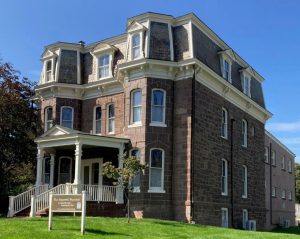
A dear neighbor, a trustee of The Hopewell Museum and chair of its Nominating Committee, flattered me in late fall 2023 with an offer. Would I like to become a board member of the town’s history museum? The Museum’s 1877 home on East Broad Street, its two-storied massing of graystone graced atop by double dormers and mansard roofs, had often struck me as a non sequitor, better suited to a boulevard in Second Empire Paris than its small-town surroundings in Hopewell Borough.
But it was precisely this anomalous presence that roused my interest since moving to town in 2020. I was also curious as to why the building stood utterly silent, its doors and blinds shut.
Over the course of my interviews for the board, I learned that the museum had, in fact, been closed for quite some time, in part because of the pandemic, but also due to an unexpected, exciting proposition: The trustees were in the process of implementing “Reimagination,” a $1.5 million museum revamp, inside and out. Not only to restore the building’s exterior and invigorate its interior space, but also to launch a multiphase plan that ensured the museum’s vibrancy and relevance for generations: community outreach, visitor experience, and expanded educational and research programs.
In other words, I was about to join a team committed to important work, albeit staggering tasks, performed in the midst of a major construction project.
Reader, I accepted.
As mundane as it may seem, Reimagination’s first unimagining step was to empty the building entirely, attic to basement. Herculean labor, to put it mildly. Thus, our archivists, consultants, volunteers, trustees, and stalwart Executive Director, Asher Lurie, coordinated a systematic rummaging process—through vaults, closets, drawers, racks, and vitrines—assessing, cataloguing, and photographing every item, remediating—e.g., freezing and preserving garments that may hide damaging insects —then boxing the entire lot, and transporting each artifact—13,000 of them, many rare and delicate—to a secure, climate-controlled offsite storage.
Phew.
It took seven months, but the museum’s interior has been effectively evacuated, rendered unrecognizable, the reversal of 103 years of assemblage, to create a vibrant, uncluttered possibility.
Enter LAYER Architecture of Philadelphia, an award-winning interior design firm for major projects at The Pennsylvania State University, The Lawrenceville School, and other prestigious institutions. In July, the Board approved LAYER’s ambitious plan for newly configured rooms, new mechanicals, new lighting, and expanded capacity.
Just last month, a bidding process climaxed in the selection of a general contractor, Princeton-based C. Raymond Davis & Sons. CRD’s historical renovation projects, at the Hun School of Princeton, Cap and Gown Club at Princeton University, the Quaker School at Horsham, and many others, made them our clear choice. Construction begins this month!
Our collection had accrued since 1922, when the Hopewell Free Public Library and Museum Funding and Building Association was incorporated, and when its benefactor, Miss Sarah D. Stout, passed away. Miss Stout descended from one of Hopewell Valley’s original families that settled here in 1690.
Her will’s bequest served as institutional yeast, as described in a letter by one of the Weart sisters, Sue and Eleanor, who curated and sustained the museum’s growth over many years:
“Miss Sarah decided to leave her collection of records and jewelry, silver, silver spoons, wearing apparel, glass, china, brass, iron, books, furniture, bric-a-brac, and all of such personal effects to our Library; we are greatly interested in it, for Mr. & Miss Stout made it their life work and it is very valuable.” – Susan Stout Weart, December 13, 1920
Indeed, our founders’ spirit derived from the distaff side. Because of this the heart of the collection is unusually female—unique among museums. Namely…
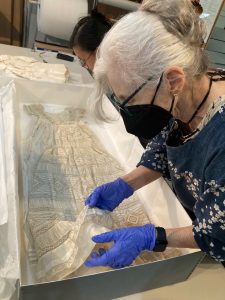
An extensive collection of approximately 2,000 pieces of clothing and textiles spanning from the late 18th to early 20th century…
…anniversary quilts…
…needlework…
…nineteenth-century poupé and bébé dolls made of porcelain, wood, or wax…
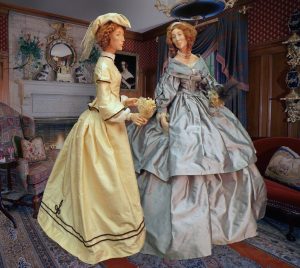
…costumed mannequins made by twentieth-century fashion illustrator and seamstress, Lorraine Alippe, depicting twelve women donning fashion typical of the decades, 1820 to 1920.
…toys
…and an outré array of wreaths made from human hair, a popular Victorian pastime, tresses woven around thin wire forming delicate floral patterns.
Over the decades, Hopewell Museum has evolved and broadened, of course, but it still serves as a lens into eighteenth- and nineteenth-century domestic life: women’s avocations, “fancy work” skills, family pastimes, and the rearing of children.
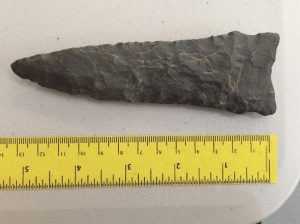
Geographically, the museum’s building resides on Native American ancestral land, which underscores the wealth of our Lenni Lenape collection—stone tools, weapons, pottery, and carvings.
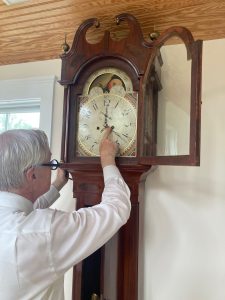 One of our two antique tall-case clocks was built in the early 1800s by the leading clockmaker in nineteenth century New Jersey, Flemington’s Joakim Hill, in collaboration with master woodcarver John Scudder, of Westfield, New Jersey. It was owned by Elder John Boggs of Hopewell’s Old School Baptist Church on West Broad Street. To this day, it keeps accurate time.
One of our two antique tall-case clocks was built in the early 1800s by the leading clockmaker in nineteenth century New Jersey, Flemington’s Joakim Hill, in collaboration with master woodcarver John Scudder, of Westfield, New Jersey. It was owned by Elder John Boggs of Hopewell’s Old School Baptist Church on West Broad Street. To this day, it keeps accurate time.
While George Washington may not have slept in Hopewell, he may well have quaffed ale from one of our collection’s pewter tankards. In June of 1778, after the winter in Valley Forge, Washington encamped the Continental Army (10,000 soldiers) for two nights at John Hart’s farm on Lambertville-Hopewell Road, a mile from the Museum. On June 25th, Washington would have ridden past the future site of the Museum toward Princeton, leading the army’s thirty-mile march to Monmouth Courthouse, where they disrupted the British retreat to New York.
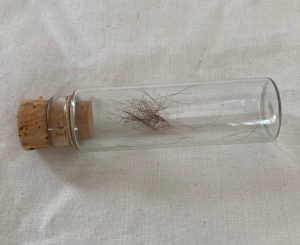
John Hart’s dark hair is preserved in a museum vial. The Borough’s most famous son, Hart was a major landowner in Hopewell Township and one of New Jersey’s five signers of the Declaration of Independence. He’s buried in the Old School Baptist Church cemetery, a five-minute walk from the museum. The museum owns a framed vellum deed, signed by Hart. On July 4, 1766, he sold large parcels of land adjoining Stony Brook to Philadelphia merchants. Ten years later he signed our nation’s founding document.
Queen Anne-, Chippendale-, Federal-, and Sheraton-style furniture, farm tools, militaria, powder-horns, and swords, Civil War uniforms, colonial home furnishings—it is a superlative collection for a small, quintessential American town and holds much interest to anyone interested in the growth of our nation.
 Perhaps the most meticulous effort in Reimagination’s boxing-up fell to an expert in the field of preventive conservation. A veteran from the Metropolitan Museum of Art, Museum of Fine Arts-Boston, and the Smithsonian Institution, Wendy Jessup (with help from a graduate fellow at the Winterthur & University of Delaware Program in Art Conservation, Binh-An Nguyen, and two interns) examined hundreds of our rare textiles to rid them of the age-old museum nemesis: carpet beetles, or more precisely, the cast-off exoskeletons of their larvae and frass. These critters can wreak irreversible havoc to a collection. To ensure preservation, our textiles had to be frozen for days at lower than minus-35-degree temperatures.
Perhaps the most meticulous effort in Reimagination’s boxing-up fell to an expert in the field of preventive conservation. A veteran from the Metropolitan Museum of Art, Museum of Fine Arts-Boston, and the Smithsonian Institution, Wendy Jessup (with help from a graduate fellow at the Winterthur & University of Delaware Program in Art Conservation, Binh-An Nguyen, and two interns) examined hundreds of our rare textiles to rid them of the age-old museum nemesis: carpet beetles, or more precisely, the cast-off exoskeletons of their larvae and frass. These critters can wreak irreversible havoc to a collection. To ensure preservation, our textiles had to be frozen for days at lower than minus-35-degree temperatures.
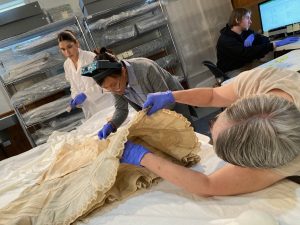 Before freezing, the items must be cushioned with pads to prevent folds, and wrapped with a sufficient amount of paper to buffer them. Otherwise, when removed from deep-freeze, the change of humidity can cause condensation which can stain.
Before freezing, the items must be cushioned with pads to prevent folds, and wrapped with a sufficient amount of paper to buffer them. Otherwise, when removed from deep-freeze, the change of humidity can cause condensation which can stain.
As of May 2025, Jessup and her team have documented and frozen over 1,400 dresses, coats, hats, slippers, bed linens, doilies, flags, and curtains. A remarkable, vital achievement.
Now that the collection is packed and stored and the building ready for renovation, the Museum’s trustees are planning a renewed visitor experience—unfolding Hopewell Valley’s story through illustrative exhibits and narrative displays. Our grand reopening is slated for late 2026.
As in all town museums, our collection is held in the public trust. Its presentation must underscore the integrity of the cultures that lived here and preserve their heritage for posterity. Reimagination will ensure just that.

Eric Lubell is a board trustee of The Hopewell Museum and Hopewell resident who worked as a writer and creative director in the audio-visual business for over forty years. His work can be viewed in museums around the world (Bermuda Underwater Exploration Institute, Malaysia National Science Centre, Kaohsiung National Science and Technology Museum, American Museum of Natural History, ProRodeo Hall of Fame, and Kennedy Space Center’s SpacePort USA). For ten years, he wrote the American Society of Magazine Editors’ National Magazine Awards and Glamour Magazine‘s Women of the Year Awards. He founded The Independent: A Journal for Princeton and served as its editor-in-chief, publishing essays, criticism, and fiction by Princeton alumni for the university community.
